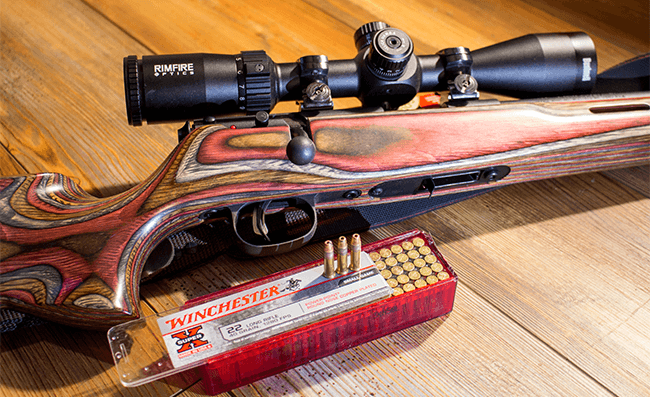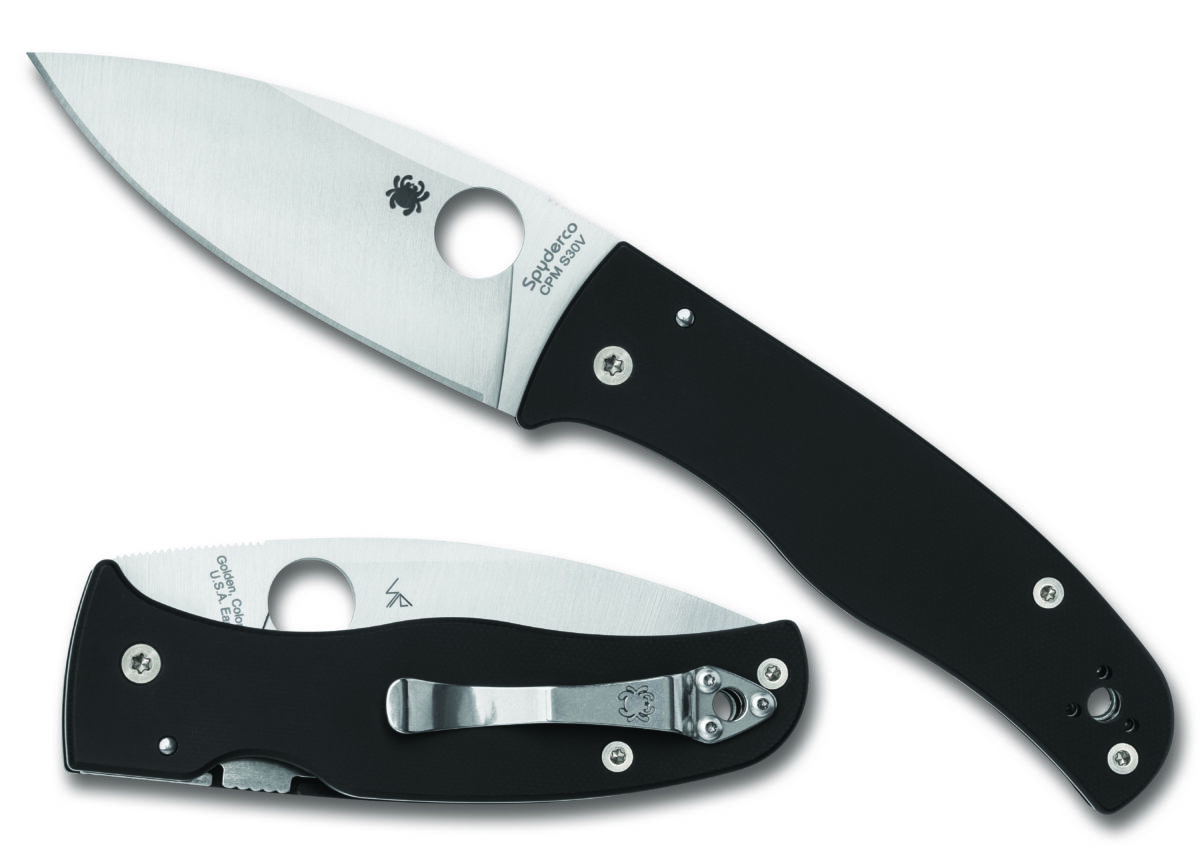
The .22 Long Rifle — 100-Plus Years and Still Going Strong
By Phil Massaro
The class of .22 rimfires is one that is so useful, I firmly believe every hunter should own one. It is perfect for training, hunting and developing marksmanship skills alike, and while many associate the family of cartridges with young hunters just starting out, I, as an experienced big game hunter who has hunted around the world, find myself reaching for my favorite old .22 more often than not.
So Many Virtues
The beauty of the .22 rimfire is the ease of shooting. There is no recoil and very little report, which makes it not only perfect for training a new shooter, but equally important for honing an experienced shooter’s skills. With a good rifle, using your .22 to ensure your shooting mechanics are on point is an important part of hunt preparation, especially if you are using a hard-kicking rifle for big game. But, aside from being a training tool, the .22 can be used for many small-game hunts, such as squirrels, rabbits, foxes, woodchucks prairie dogs and more.

The .22 Long Rifle is an excellent tool for target shooting, hunting small game and training new shooters.
For the hunter, a rifle is more often the go-to tool than the handgun, but with either, virtually any shooter can enjoy the benefits and virtues of the .22 Long Rifle. Whether iron-sighted or scoped, a good old-fashioned squirrel hunt in the mild, beautiful days of autumn is certain to be a memory maker. Late-season rabbit hunting — I love those cold, but bright days when the cottontails come out of their holes to sun themselves — can be a test of both hunting skills and marksmanship. The beauty of both these types of hunts is that the .22 Long Rifle doesn’t ruin a lot of meat.
Small to Magnum and Everything In Between
Unlike big-game cartridges like the .270 Winchester and .30-’06 Springfield, which are centerfire cartridges (with the primer located centrally in the cartridge head) the .22 has the priming compound — the material that sparks and ignites the powder in the case — located in the cartridge rim, hence the name “rimfire.”
Undoubtedly, the most popular .22 rimfire is the .22 Long Rifle, but it isn’t the only member of this cartridge family. Dating back to the 1850s, the .22-caliber rimfire is among our oldest cartridges. The first of the .22 rimfires was the .22 Short, released in 1857, followed by the .22 Long in 1871. Both used a .22-caliber 29-grain bullet. They both also all use a case of the same diameter, though at different lengths, with the Long developing higher velocities than the Short.

The .22 Long was a definite improvement over the .22 Short, extending the effective range of the rimfire.
In 1880, the .22 Extra Long was released. It used a longer case and a heavier 40-grain bullet, achieving a muzzle velocity of 1,050 feet per second (fps). Today, it is the most rare of the .22 rimfire cartridges.
Mating the heavier 40-grain bullet of the Extra Long with the case length of the .22 Long, J. Stevens & Co. released the .22 Long Rifle in 1887, and the rest, as they often say, is history. The .22 Long Rifle, often written as .22 LR, is the most popular of the lot. Both pistols and revolvers are chambered in .22 Long Rifle, and among the rifles it has been chambered in just about every conceivable action type, from single-shots to pumps and autoloaders to bolt-actions, precision Olympic-class target guns and plain Jane hunting arms.
There are other .22 rimfires that are noteworthy, such as the .22 Winchester Magnum Rimfire (often called simply the .22 Mag or .22 WMR) and its much older predecessor, the .22 Winchester Rimfire (or .22 WRF). Both use a larger diameter case than does the .22 Short, Long or Long Rifle, with the much more popular .22 Magnum driving a 40-grain bullet to over 1,800 fps and a 50-grain bullet to over 1,500 fps. In spite of the hefty velocity increase, the additional cost of the .22 Magnum ammunition keeps the more affordable .22 Long Rifle on top of the heap.
Lots of Ammo Choices
There are many types of ammunition for the .22 Long Rifle, and each serves a different purpose. The classic design is a wax-coated, roundnose lead bullet driven to a muzzle velocity of just about 1,200 fps. It is inexpensive to produce, yet very effective on small-game animals. There are also plated hollowpoints, designed to transfer maximum energy to a game animal, thus expediting dispatch.

Federal’s Gold Medal Match .22 Long Rifle ammunition is wonderfully accurate.
Then there are those boxes labeled “match ammunition.” These .22 LRs are designed to give the most uniform accuracy and are favorites for target competitors, but they can be surprisingly wonderful for hunting as well. I’ve had great luck with precise head shots on squirrels that are wise to area hunters and don’t present a larger broadside target. There is also high-velocity .22 Long Rifle ammunition on the market — such as the famous CCI Stinger — which will use a lighter bullet at a higher velocity. If you appreciate a flatter trajectory, or perhaps a bit more energy transfer, these can be very effective for small-game hunting. I like the Stinger and other comparable high-velocity ammunition for those woodchucks that invade our garden each summer, as well as for longer shots on furbearing mammals like coyotes and foxes.

Winchester’s Power Point ammunition, with a hollowpoint for quick expansion, is an excellent all-around choice for small-game hunting.
Can I Shoot the .22 Short in My .22 LR?
You may have heard that a .22 LR firearm can be shot with other ammunition in the .22 rimfire family. That is partly true. With many firearms that have a barrel stamp indicating it chambers the .22 LR, you may be able to use the two shorter cartridges, the .22 Short and .22 Long. Revolvers and singe-shot, bolt-action, pump-action and lever-action rifles marked “.22 LR,” especially older firearms, can almost always shoot all three. A firearm marked “.22 Long” will likewise almost always accept the shorter .22 Short, but it will not accept and you should never attempt to shoot the .22 LR in it. And, finally, a firearm stamped .22 Short, the shortest of the family, should only be fired with .22 Short ammo.

The original .22 rimfire, the .22 Short. It still makes a fun plinking cartridge.
It’s important to note that this interchangeability is not available in nor recommended for the vast majority of semi-automatic handguns and rifles chambered and stamped for use with .22 LR. Too, there are many firearms today engineered specifically for the .22 LR; you’ll find these guns stamped “.22 LR only,” and that should be adhered to without exception. (Remember, one of the tenets of firearms and hunting safety is to always make sure you’re using the correct ammo for your firearm, and “only” means just that — only what the gun is stamped to accept.) Under no circumstances should you attempt to fire the two bigger .22 rimfire cartridges .22 WMR and .22 WRF. If you are unsure what kind of .22 ammunition your firearm is capable of firing beyond the caliber stamped on its barre or frame, consult your owner’s manual, the manufacturer of your gun and/or an expert at your local firearms retail center for confirmation.
Know Its Limitations
How far is too far with a .22 Long Rifle? Well, that depends on what you’re hunting, but a good rule of thumb when hunting with the .22 Long Rifle is to stay inside of 50 yards. You can definitely use your .22 Long Rifle as a 100-yard target rifle, but hunting at those distances is questionable, as the bullet’s trajectory changes rapidly as distances increase and striking energy drops off quickly. Together, that compromises your ability to effect a quick and ethical kill.
Your firearm is as much a part of the equation as your choice of .22 LR ammunition. You may have to experiment with different types and brands to find out which will shoot best in your chosen rifle or handgun. Keep in mind that many semi-automatic rifles, like the popular Ruger 10/22, may require a certain energy level to properly cycle the action.
I know many hunters who will argue, until blue in the face, about the proper deer or elk cartridge, or the best Cape buffalo cartridge, but I can proudly say that none of them will ever dismiss the effectiveness of the .22 Long Rifle! Give one — or two or three — a try. I promise it will open up new hunting avenues to you and improve your skills along the way.


 The partnership between firearm manufacturers and wildlife conservation agencies is a model for the world. It shows how industry participation can positively impact the environment and highlights the need for ongoing support for conservation efforts.
In short, the relationship between firearm manufacturers and wildlife conservation is vital. By understanding how excise taxes and industry contributions fund conservation, hunters and shooters can see the positive impact their purchases have on preserving nature for future generations.
Partner with a Payer
The Partner with a Payer initiative was developed to help generations of employees in the firearm, archery and angling industries, state agencies and the U.S. Fish and Wildlife Service to better understand their, and each other’s, roles in conservation.
The partnership between firearm manufacturers and wildlife conservation agencies is a model for the world. It shows how industry participation can positively impact the environment and highlights the need for ongoing support for conservation efforts.
In short, the relationship between firearm manufacturers and wildlife conservation is vital. By understanding how excise taxes and industry contributions fund conservation, hunters and shooters can see the positive impact their purchases have on preserving nature for future generations.
Partner with a Payer
The Partner with a Payer initiative was developed to help generations of employees in the firearm, archery and angling industries, state agencies and the U.S. Fish and Wildlife Service to better understand their, and each other’s, roles in conservation.













 Excise taxes fund wildlife research for the sustainable maintenance of healthy wildlife populations.[/caption]
The excise taxes established under the Pittman-Robertson Act have been a driving force, contributing over $16.4 billion (over $25 billion adjusted for inflation) to individual states. In this video, Peter Novotny, Deputy Chief of the Ohio Division of Wildlife, highlights how these funds, combined with hunting and fishing license dollars, fund essential wildlife research. This research enables a deeper understanding of how wildlife populations adapt to a changing environment, ultimately leading to the maintenance of healthy and sustainable populations.
Excise taxes fund wildlife research for the sustainable maintenance of healthy wildlife populations.[/caption]
The excise taxes established under the Pittman-Robertson Act have been a driving force, contributing over $16.4 billion (over $25 billion adjusted for inflation) to individual states. In this video, Peter Novotny, Deputy Chief of the Ohio Division of Wildlife, highlights how these funds, combined with hunting and fishing license dollars, fund essential wildlife research. This research enables a deeper understanding of how wildlife populations adapt to a changing environment, ultimately leading to the maintenance of healthy and sustainable populations.
 “We feel comfortable and confident that the excise tax dollars are helping keep healthy deer herds out there across the United States,” said Phil Bednar, President and CEO of TenPoint Crossbows.[/caption]
“We feel comfortable and confident that the excise tax dollars are helping keep healthy deer herds out there across the United States,” said Phil Bednar, President and CEO of TenPoint Crossbows.[/caption]